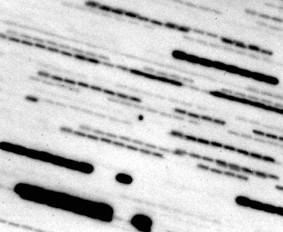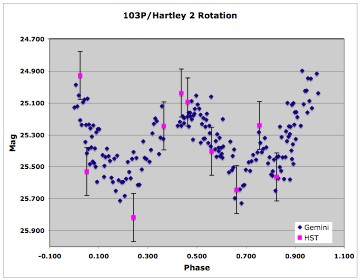2009 Annual Science Report
 University of Hawaii, Manoa
Reporting | JUL 2008 – AUG 2009
University of Hawaii, Manoa
Reporting | JUL 2008 – AUG 2009
Stardust NExT and EPOXI Mission Observing Coordination
Project Summary
The StardustNExT and EPOXI missions are extended missions to comets, scheduled to arrive on Feb. 14, 2011 and Nov. 4, 2010, respectively. Members of the UH NAI team have been participating in an international observing campaign designed to characterize the nuclei of comets 9P/Tempel 1 and 103P/Hartley 2 in advance of the encounter. In particular, during this reporting period preparation for observations and analysis of the rotation rates of the comets was undertaken.
Project Progress
After the successful completion o the Deep Impact (DI) mission in 2005, an extended mission was approved, called EPOXI, which combined extrasolar planet transit observations (EPOch) and a Deep Impact Extended investigation (DIXI) to explore the nucleus of a new comet. The goal of the DIXI misison is to search for outbursts and sources, make IR spectral maps in the coma and of the surface, look at the thermal conductivity of the surface materials and correlate the surface albedo and color with topography in order to compare a new nucleus to the suite of 4 primitive small bodies that have been previously visited by in-situ spacecraft. At the time of the selection of the target, 103P/Hartley 2, the comet’s orbit had been well-observed at 4 apparitions, but the nucleus had never been detected. The Earth-based observing campaign coordinated by our team is designed to characterize the nucleus prior to encounter, specifically to get the rotation period to 20% accuracy, understand the size and albedo of the nucleus and monitor the activity pre-encounter. The challenge was that the comet is typically very active far from perihelion, producing a large coma and tail, which prevents direct observation of the nucleus. Thus nucleus observations are challenging requiring coordinating the world’s largest telescopes in combination with the Hubble Space Telescope. An observing campaign utilizing the Large Binocular telescope, The Gemini N and S telescopes, and the Hubble Space Telescope, the ESO Very Large Telesocpe, the Gran Canary Telescope and the South African Large Telescope was coordinated during March-May 2009 to secure the rotation period. The data indicate that the period is around 16.4 hours, the nucleus is relatively small, near 0.5 km, and that the nucleus may not be ellipsoidal, having a flattened shape.
The Stardust-NExT mission utilizes the Stardust spacecraft to re-visit the Deep Impact nucleus to attempt to image the crater that was not seen during the DI encounter because there was so much dust, and in addition to look at changes that occur on a comet nucleus between two successive perihelion passages. The challenge was to be able to predict the rotation period with sufficient accuracy that the final trajectory correction maneuver in Feb. 2010 would allow the spacecraft to fly past the side of the rotating nucleus that had the impact crater a year later. Not only is it known that the rotation period is changing each perilhelion passage, but that the rate of change is increasing from the outgassing torques. An intense international campaign has been planned for fall 2009, with time awarded on HST (just after the servicing mission), and telescopes in Hawaii, Arizona, Tenerife, China, Korea and India.

Composite image of the comet obtained with the Gemini 8m telescope on 5/22/09 through
a red filter. The image is a composite of short exposures totaling 8100 seconds exposure.
The comet was at 4.52 AU from the sun, with no evidence of any dust production.

Data from Gemini N and S telescopes (blue points; May 21-23) phased to a 16.4 hour rotation period, along with the data from the Hubble Space Telescope taken during April 10-11, 2009.
Publications
-
Lisse, C. M., Fernandez, Y. R., Reach, W. T., Bauer, J. M., A’Hearn, M. F., Farnham, T. L., … Snodgrass, C. D. (2009). Spitzer Space Telescope Observations of the Nucleus of Comet 103P/Hartley 2. Publications of the Astronomical Society of the Pacific, 121(883), 968–975. doi:10.1086/605546
- Cochran, A.L., Meech, K.J. & Weaver, H.A. (2009). Goals and Priorities for the Study of Comets in the Next Decade (2011 – 2020). Division for Planetary Sciences Meeting Abstracts.
- Fernandez, Y.R., Lisse, C.M., Reach, W.T., Bauer, J.M., A’Hearn, M.F., Farnham, T.L., Groussin, O., Belton, M.J.S., Meech, K.J. & Snodgrass, C. (2009). Spitzer Space Telescope Observations of the Nucleus and Trail of Comet 103P/Hartley 2.
- Meech, K.J., Hainaut, O., Weaver, H.A., Snodgrass, C., Pittichova, J., Pittichova, J., Riesen, T., Vilas, F., A’Hearn, M.F., Licandro, J., Gulbis, A. & Lowry, S. (2009). Characterization of the Nucleus of 103P/Hartley 2 for the EPOXI Mission.
- Meech, K.J., Pittichová, J. & Delsanti, A. (2009). The Earth-Based Deep Impact Observing Program.
-
PROJECT INVESTIGATORS:
-
PROJECT MEMBERS:
Olivier Hainaut
Collaborator
Jacqueline Keane
Postdoc
Timm Riesen
Postdoc
Jana Pittichova
Research Staff
Heather Kaluna
Graduate Student
Sarah Sonnett
Graduate Student
Anthony Zenn
Graduate Student
Michael A'Hearn
Unspecified Role
Amanda Gulbis
Unspecified Role
Javier Licandro
Unspecified Role
Steven Lowry
Unspecified Role
Colin Snodgrass
Unspecified Role
Faith Vilas
Unspecified Role
Harold Weaver
Unspecified Role
-
RELATED OBJECTIVES:
Objective 2.2
Outer Solar System exploration
Objective 3.1
Sources of prebiotic materials and catalysts